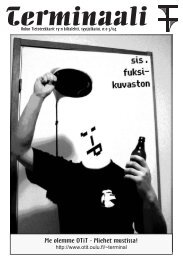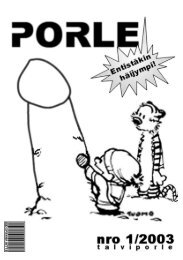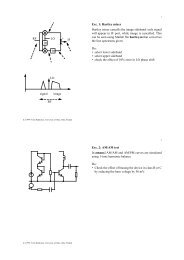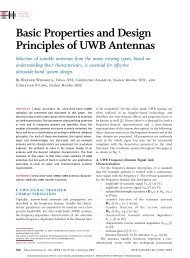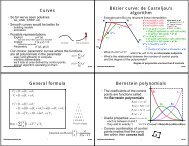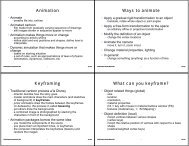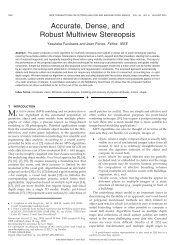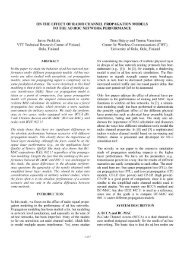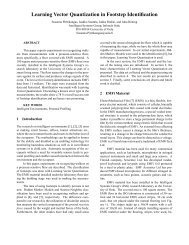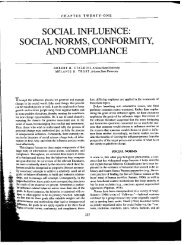Accurate and Practical Calibration of a Depth and Color ... - Oulu
Accurate and Practical Calibration of a Depth and Color ... - Oulu
Accurate and Practical Calibration of a Depth and Color ... - Oulu
You also want an ePaper? Increase the reach of your titles
YUMPU automatically turns print PDFs into web optimized ePapers that Google loves.
<strong>Accurate</strong> <strong>and</strong> <strong>Practical</strong> <strong>Calibration</strong> <strong>of</strong> a <strong>Depth</strong><br />
<strong>and</strong> <strong>Color</strong> Camera Pair<br />
Daniel Herrera C., Juho Kannala, <strong>and</strong> Janne Heikkilä<br />
Machine Vision Group<br />
University <strong>of</strong> <strong>Oulu</strong><br />
{dherrera,jkannala,jth}@ee.oulu.fi<br />
Abstract. We present an algorithm that simultaneously calibrates a<br />
color camera, a depth camera, <strong>and</strong> the relative pose between them. The<br />
method is designed to have three key features that no other available<br />
algorithm currently has: accurate, practical, applicable to a wide range<br />
<strong>of</strong> sensors. The method requires only a planar surface to be imaged from<br />
various poses. The calibration does not use color or depth discontinuities<br />
in the depth image which makes it flexible <strong>and</strong> robust to noise. We<br />
perform experiments with particular depth sensor <strong>and</strong> achieve the same<br />
accuracy as the propietary calibration procedure <strong>of</strong> the manufacturer.<br />
Keywords: calibration, depth camera, camera pair<br />
1 Introduction<br />
Obtaining depth <strong>and</strong> color information simultaneously from a scene is both<br />
highly desirable <strong>and</strong> challenging. <strong>Depth</strong> <strong>and</strong> color are needed in applications<br />
ranging from scene reconstruction to image based rendering. Capturing both<br />
simultaneously requires using two or more sensors. A basic device for scene reconstruction<br />
is a depth <strong>and</strong> color camera pair. Such a camera pair consists <strong>of</strong> a<br />
color camera rigidly attached to a depth sensor (e.g. time-<strong>of</strong>-flight (ToF) camera,<br />
laser range scanner, structured light scanner).<br />
In order to reconstruct a scene from the camera pair measurements the system<br />
must be calibrated. This includes internal calibration <strong>of</strong> each camera as<br />
well as relative pose calibration between the cameras. <strong>Color</strong> camera calibration<br />
has been studied extensively [1, 2] <strong>and</strong> different calibration methods have been<br />
developed for different depth sensors. However, independent calibration <strong>of</strong> the<br />
cameras may not yield the optimal system parameters, <strong>and</strong> a comprehensive calibration<br />
<strong>of</strong> the system as a whole could improve individual camera calibration<br />
as it allows to use all the available information.<br />
Previous work. A st<strong>and</strong>ard approach is to calibrate the cameras independently<br />
<strong>and</strong> then calibrate only the relative pose between them [3–5]. This may<br />
not be the optimal solution as measurements from one camera can improve the<br />
calibration <strong>of</strong> the other camera. Moreover, the independent calibration <strong>of</strong> a depth<br />
camera can require a high precision 3D calibration object that can be avoided<br />
using joint calibration.<br />
Fuchs <strong>and</strong> Hirzinger [6] propose a multi-spline model for ToF cameras. Their<br />
model has a very high number <strong>of</strong> parameters <strong>and</strong> it requires a robotic arm to
know the exact pose <strong>of</strong> the camera. Lichti [7] proposes a calibration method<br />
for an individual laser range scanner using only a planar calibration object. It<br />
performs a comprehensive calibration <strong>of</strong> all parameters. However, it relies on<br />
the varying response <strong>of</strong> the scanner to different surface colors to locate corner<br />
features on the image.<br />
Zhu et al. [8] describe a method for fusing depth from stereo cameras <strong>and</strong><br />
ToF cameras. Their calibration uses the triangulation from the stereo cameras as<br />
ground truth. This ignores the possible errors in stereo triangulation <strong>and</strong> measurement<br />
uncertainties. The different cameras are thus calibrated independently<br />
<strong>and</strong> the parameters obtained may not be optimal.<br />
Motivation. As a motivation for our work, we propose three requirements<br />
that an optimal calibration algorithm must have. To the best <strong>of</strong> our knowledge,<br />
no available calibration algorithm for a depth <strong>and</strong> color camera pair fulfills all<br />
three criteria.<br />
<strong>Accurate</strong>: The method should provide the best combination <strong>of</strong> intrinsic <strong>and</strong><br />
extrinsic parameters that minimizes the reprojection error for both cameras over<br />
all calibration images. This may seem like an obvious principle but we stress it<br />
because partial calibrations, where each camera is calibrated independently <strong>and</strong><br />
the relative pose is estimated separately, may not achieve the best reprojection<br />
error.<br />
<strong>Practical</strong>: The method should be practical to use with readily available materials.<br />
A high precision 3D calibration object is not easy/cheap to obtain <strong>and</strong> a<br />
robotic arm or a high precision mechanical setup to record the exact pose <strong>of</strong> the<br />
camera pair is usually not practical, whereas a planar surface is usually readily<br />
available.<br />
Widely applicable: To be applicable to a wide range <strong>of</strong> depth sensors, one cannot<br />
assume that color discontinuities are visible on the depth image. Moreover,<br />
some depth sensors, like the one used for our experiments, may not provide accurate<br />
measurements at sharp depth discontinuities. Thus, neither color nor depth<br />
discontinuities are suitable features for depth camera calibration. The method<br />
should use features based on depth measurements that are most reliable for a<br />
wide range <strong>of</strong> cameras.<br />
2 The depth <strong>and</strong> color camera pair<br />
Our setup consists <strong>of</strong> one color camera <strong>and</strong> one depth sensor rigidly attached<br />
to each other. Our implementation <strong>and</strong> experiments use the Kinect sensor from<br />
Micros<strong>of</strong>t, which consists <strong>of</strong> a projector-camera pair as the depth sensor that<br />
measures per pixel disparity. The Kinect sensor has gained much popularity<br />
in the scientific <strong>and</strong> the entertainment community lately. The complete model<br />
includes 20 + 6N parameters where N is the number <strong>of</strong> calibration images. The<br />
details <strong>of</strong> the model are described below.<br />
<strong>Color</strong> camera intrinsics. We use a similar intrinsic model as Heikkilä <strong>and</strong><br />
Silven [1] which consists <strong>of</strong> a pinhole model with radial <strong>and</strong> tangential distortion<br />
correction. The projection <strong>of</strong> a point from color camera coordinates<br />
xc = [xc, yc, zc] ⊤ to color image coordinates p c = [uc, vc] ⊤ is obtained through
the following equations. The point is first normalized by xn = [xn, yn] ⊤ [xc/zc, yc/zc]<br />
=<br />
⊤ . Distortion is then performed:<br />
�<br />
2k3xnyn + k4(r<br />
xg =<br />
2 + 2x2 �<br />
n)<br />
(1)<br />
k3(r 2 + 2y 2 n) + 2k4xnyn<br />
xk = (1 + k1r 2 + k2r 4 )xn + xg<br />
where r 2 = x 2 n + y 2 n <strong>and</strong> k is a vector containing the four distortion coefficients.<br />
Finally the image coordinates are obtained:<br />
� � � � � �<br />
uc fcx 0 xk<br />
=<br />
+<br />
vc 0 fcy<br />
yk<br />
� uc0<br />
The complete color model is described by Lc = {fcx, fcy, uc0, vc0, k1, k2, k3, k4}.<br />
<strong>Depth</strong> camera intrinsics. In our experiments we used the increasingly popular<br />
Kinect sensor as a depth camera [9]. However, the method allows any kind<br />
<strong>of</strong> depth sensor to be used by replacing this intrinsic model. The Kinect consists<br />
<strong>of</strong> an infrared projector that produces a constant pattern <strong>and</strong> a camera that<br />
measures the disparity between the observed pattern <strong>and</strong> a pre-recorded image<br />
at a known constant depth. The output consists <strong>of</strong> an image <strong>of</strong> scaled disparity<br />
values.<br />
The transformation between depth camera coordinates xd = [xd, yd, zd] ⊤ <strong>and</strong><br />
depth image coordinate p d = [ud, vd] follows the same model used for the color<br />
camera. The distortion correction did not improve the reprojection error <strong>and</strong> the<br />
distortion coefficients were estimated with very high uncertainty. Therefore we<br />
do not use distortion correction for the depth image.<br />
The relation between the disparity value d <strong>and</strong> the depth zd is modeled using<br />
the equation:<br />
zd =<br />
1<br />
α(d − β)<br />
where α <strong>and</strong> β are part <strong>of</strong> the depth camera intrinsic parameters to be calibrated.<br />
The model for the depth camera is described by Ld = {fdx, fdy, ud0, vd0, α, β}.<br />
Extrinsics <strong>and</strong> relative pose. Figure 1 shows the different reference frames<br />
present in a scene. Points from one reference frame can be transformed to another<br />
using a rigid transformation denoted by T = {R, t}, where R is a rotation<br />
<strong>and</strong> t a translation. For example, the transformation <strong>of</strong> a point xw from world<br />
coordinates {W } to color camera coordinates {C} follows xc = Rcxw + tc.<br />
Reference {V } is anchored to the corner <strong>of</strong> the calibration plane <strong>and</strong> is only<br />
used for initialization. The relative pose Tr is constant, while each image has its<br />
own pose Tc, resulting in 6 + 6N pose parameters.<br />
3 <strong>Calibration</strong> method<br />
We use a planar checkerboard pattern for calibration which can be constructed<br />
from any readily available planar surface (e.g. a flat table, a wall). The checkerboard<br />
corners provide suitable constraints for the color images, while the planarity<br />
<strong>of</strong> the points provides constraints on the depth image. The pixels at the<br />
vc0<br />
�<br />
(2)<br />
(3)<br />
(4)
{D}<br />
Tr<br />
{C}<br />
Td<br />
Tc<br />
zv<br />
{V}<br />
Fig. 1: Reference frames <strong>and</strong> transformations present on a scene. {C} <strong>and</strong> {D}<br />
are the color <strong>and</strong> depth cameras’ reference frames respectively. {V } is the reference<br />
frame anchored to the calibration plane <strong>and</strong> {W } is the world reference<br />
frame anchored to the calibration pattern.<br />
borders <strong>of</strong> the calibration object can be ignored <strong>and</strong> thus depth discontinuities<br />
are not needed. Figure 2 shows a sample image pair used for calibration. Figure<br />
Fig. 2: Sample calibration images. Note the inaccuracies at the table’s edge.<br />
3 shows the steps <strong>of</strong> the calibration <strong>and</strong> its inputs. An initial estimation for the<br />
calibration parameters is obtained by independently calibrating each camera.<br />
The depth intrinsic parameters Ld <strong>and</strong> the relative pose Tr are then refined using<br />
a non-linear optimization. Finally, all parameters are refined simultaneously.<br />
Corner based calibration. The calibration <strong>of</strong> a color camera is a well studied<br />
problem, we use Zhang’s method [2, 10] to initialize the camera parameters.<br />
Briefly, the steps are the following. The checkerboard corners are extracted from<br />
the intensity image. A homography is then computed for each image using the<br />
known corner positions in world coordinates {W } <strong>and</strong> the measured positions<br />
in the image. Each homography then imposes constraints on the camera parameters<br />
which are then solved with a linear system <strong>of</strong> equations. The distortion<br />
coefficients are initially set to zero.<br />
The same method is used to initialize the depth camera parameters. However,<br />
because the checkerboard is not visible in the depth image, the user selects the<br />
four corners <strong>of</strong> the calibration plane (the whole table in figure 2). These corners<br />
are very noisy <strong>and</strong> are only used here to obtain an initial guess. The homography<br />
is thus computed between {V } <strong>and</strong> {D}. This initializes the focal lengths,<br />
zw<br />
{W}
Checkerboard<br />
corners<br />
Corner<br />
based calib.<br />
Plane<br />
corners<br />
Corner<br />
based calib.<br />
Tc<br />
Td<br />
Lc, Tc<br />
Tr<br />
estimation<br />
Ld<br />
Tr<br />
Ld <strong>and</strong> Tr<br />
refinement<br />
Global<br />
refinement<br />
<strong>Depth</strong><br />
points<br />
Fig. 3: Block diagram <strong>of</strong> the calibration algorithm. Left <strong>of</strong> dashed line: initialization.<br />
Right <strong>of</strong> dashed line: non-linear minimization.<br />
principal point, <strong>and</strong> the transformation Td. Using these initial parameters we<br />
obtain a guess for the depth <strong>of</strong> each selected corner. With this depth <strong>and</strong> the<br />
inverse <strong>of</strong> the measured disparity an overdetermined system <strong>of</strong> linear equations<br />
is built using (4), which gives an initial guess for the depth parameters (α <strong>and</strong><br />
β).<br />
Relative pose estimation. The independent calibrations give an estimation<br />
<strong>of</strong> the transformations Tc <strong>and</strong> Td. However, the reference frames {W } <strong>and</strong> {V }<br />
are not aligned. By design we know that they are coplanar. We can use this<br />
information by extracting the plane equation in each reference frame <strong>and</strong> using<br />
it as a constraint. We define a plane using the equation n ⊤ x − δ = 0 where n is<br />
the unit normal <strong>and</strong> δ is the distance to the origin.<br />
If we divide a rotation matrix into its colums R = [r1, r2, r3] <strong>and</strong> know that<br />
the parameters <strong>of</strong> the plane in both frames are n = [0, 0, 1] ⊤ <strong>and</strong> δ = 0, the<br />
plane parameters in camera coordinates are:<br />
n = r3 <strong>and</strong> δ = r ⊤ 3 t (5)<br />
where we use Rc <strong>and</strong> tc for the color camera <strong>and</strong> Rd <strong>and</strong> td for the depth camera.<br />
As mentioned by Unnikrishnan <strong>and</strong> Hebert [4] the relative pose can be obtained<br />
in closed form from several images. The plane parameters for each image<br />
are concatenated in matrices <strong>of</strong> the form: Mc = [nc1, nc2, ..., ncn], bc =<br />
[δc1, δc2, ..., δcn], <strong>and</strong> likewise for the depth camera to form Md <strong>and</strong> bd. The<br />
relative transformation is then:<br />
R ′ r = MdM ⊤ c <strong>and</strong> tr = (McM ⊤ c ) −1 Mc(bc − bd) ⊤<br />
Due to noise R ′ r may not be orthonormal. We obtain a valid rotation matrix<br />
through SVD using: Rr = UV ⊤ where USV ⊤ is the SVD <strong>of</strong> R ′ r.<br />
Non-linear minimization. The calibration method aims to minimize the<br />
weighted sum <strong>of</strong> squares <strong>of</strong> the measurement reprojection errors. The error for<br />
the color camera is the Euclidean distance between the measured corner position<br />
p c <strong>and</strong> its reprojected position p ′ c. Whereas for the depth camera it is the difference<br />
between the measured disparity d <strong>and</strong> the predicted disparity d ′ obtained<br />
by inverting (4). Because the errors have different units, they are weighted using<br />
(6)
the inverse <strong>of</strong> the corresponding measurement variance, σ2 c <strong>and</strong> σ2 d . The resulting<br />
cost function is:<br />
c = σ −2<br />
c<br />
� �<br />
(uc − u ′ c) 2 + (vc − v ′ c) 2� + σ −2<br />
�<br />
′<br />
d (d − d ) (7)<br />
Note that (7) is highly non-linear. The Levenberg-Marquardt algorithm is<br />
used to minimize (7) with respect to the calibration parameters. The initialization<br />
gives a very rough guess <strong>of</strong> the depth camera parameters <strong>and</strong> relative pose,<br />
whereas the color camera parameters have fairly good initial values. To account<br />
for this, the non-linear minimization is split in two phases. The first phase uses<br />
fixed parameters for the color camera Lc <strong>and</strong> external pose Tc, <strong>and</strong> optimizes the<br />
depth camera parameters Ld <strong>and</strong> the relative pose Tr. A second minimization is<br />
performed over all the parameters to obtain an optimal estimation.<br />
Variance estimation. An initial estimate <strong>of</strong> the color measurement variance<br />
σ2 c is estimated from the residuals after the first independent calibration. An<br />
estimate <strong>of</strong> the disparity variance σ2 d is obtained from the disparity residuals<br />
after the first non-linear minimization. It is noted that, because Lc <strong>and</strong> Tc are<br />
fixed, the color residuals do not need to be computed <strong>and</strong> σ2 d plays no role in this<br />
minimization. The second minimization stage, when all parameters are refined,<br />
is then run iteratively using the previously obtained residual variances as the<br />
measurement variances for the next step until they converge.<br />
4 Results<br />
We tested our calibration method with an <strong>of</strong>f-the-shelf Kinect device. The device<br />
consists <strong>of</strong> a color camera, an infrared camera <strong>and</strong> an infrared projector arranged<br />
horizontally. The electronics <strong>of</strong> the device compute a depth map for the infrared<br />
image based on the observed pattern from the projector. We ignore the infrared<br />
image <strong>and</strong> use only the depth information <strong>and</strong> treat it as a generic depth <strong>and</strong><br />
color camera pair. We used a dataset <strong>of</strong> 55 images, 35 were used for calibration<br />
<strong>and</strong> 20 for validation. Both sets cover similar depth ranges (0.5m to 2m) <strong>and</strong><br />
a wide range <strong>of</strong> poses. For the validation set, (7) was minimized only over the<br />
external pose Tc to find the best pose for the previously obtained calibration.<br />
Parameters <strong>and</strong> residuals. The obtained calibration parameters <strong>and</strong> their<br />
uncertainties are presented in Table 1. Figure 4 presents histograms <strong>of</strong> the residuals<br />
for the validation set. The formulation <strong>of</strong> our cost function (7) allows us<br />
to use the uncertainty analysis presented by Hartley <strong>and</strong> Zisserman [11]. They<br />
show that the covariance <strong>of</strong> the estimated parameters ΣP can be obtained directly<br />
from the Jacobian <strong>of</strong> the cost function J <strong>and</strong> the covariance <strong>of</strong> the measurements<br />
ΣX using:<br />
ΣP = � J ⊤ ΣXJ �−1<br />
(8)<br />
<strong>Depth</strong> uncertainty. The disparity errors are well modeled by a gaussian distribution.<br />
Using (4) <strong>and</strong> the estimated disparity variance, we obtained numerically<br />
the expected variance in depth for each disparity value. Separate statistics are<br />
computed for each depth present in the validation set to obtain an experimental
Table 1: Obtained calibration parameters. Error estimates correspond to three<br />
times their st<strong>and</strong>ard deviation.<br />
<strong>Color</strong> internals<br />
Sample count<br />
200<br />
150<br />
100<br />
50<br />
0<br />
fcx fcy uc0 vc0 k1 k2 k3 k4<br />
532.90 531.39 318.57 262.08 0.2447 -0.5744 0.0029 0.0065<br />
±0.06 ±0.05 ±0.07 ±0.07 ±0.0004 ±0.0017 ±0.0001 ±0.0001<br />
<strong>Depth</strong> internals Relative pose (rad, mm)<br />
fdx fdy ud0 vd0 α β θr trx try trz<br />
593.36 582.74 322.69 231.48 -0.00285 1091.0 0.024 -21.4 0.7 1.0<br />
±1.81 ±2.48 ±1.34 ±1.59 ±0.00001 ±1.0 ±0.003 ±1.5 ±1.5 ±1.9<br />
−0.5 0 0.5<br />
Corner reprojection error (px)<br />
σ =0.1306<br />
c<br />
(a) <strong>Color</strong> residuals<br />
Sample count<br />
x 104<br />
4<br />
3<br />
2<br />
1<br />
0<br />
−15 −10 −5 0 5 10 15<br />
Disparity reprojection error (kinect units)<br />
σ =3.3969<br />
d<br />
(b) <strong>Depth</strong> residuals<br />
<strong>Depth</strong> error std. dev. (mm)<br />
50<br />
40<br />
30<br />
20<br />
10<br />
Experimental<br />
Predicted<br />
0<br />
0.5 1 1.5<br />
<strong>Depth</strong> (m)<br />
2<br />
(c) <strong>Depth</strong> uncertainty<br />
Fig. 4: Obtained error residuals <strong>and</strong> depth uncertainty.<br />
depth variance. Both curves are shown in Figure 4c. The experimental curve<br />
shows the expected increase in variance as the depth increases. The final drop<br />
in variance is due to low sample count at the end <strong>of</strong> the range.<br />
Comparison with manufacturer calibration. The manufacturer <strong>of</strong> the<br />
Kinect sensor, PrimeSense, has a proprietary camera model <strong>and</strong> calibration procedure.<br />
They provide an API to convert the disparity image to a point cloud<br />
in world coordinates. To validate our calibration against the one from the manufacturer,<br />
we took an image from a slanted planar surface that covers a range<br />
<strong>of</strong> depths. The disparity image was reprojected to world coordinates using our<br />
model <strong>and</strong> the manufacturer’s API. A plane was fitted to each point cloud <strong>and</strong><br />
the distance <strong>of</strong> the points to the plane was computed. The manufacturer’s reprojection<br />
had a st<strong>and</strong>ard deviation <strong>of</strong> 3.10mm from the plane, while ours was<br />
3.00mm. This proves that our calibration <strong>of</strong> the depth camera has comparable<br />
accuracy to that <strong>of</strong> the manufacturer.<br />
<strong>Color</strong>ized point cloud. The fully calibrated system can be used to obtain<br />
a colored point cloud in metric coordinates. For illustration purposes, Figure 5<br />
shows an example scene <strong>and</strong> a reprojection from a different view point.<br />
5 Conclusions<br />
The results show that our algorithm performed adequately for the chosen camera<br />
pair. In addition, we believe that our algorithm is flexible enough to be used<br />
with other types <strong>of</strong> depth sensors by replacing the intrinsics model <strong>of</strong> the depth
Fig. 5: Sample scene. <strong>Color</strong> image, depth map, <strong>and</strong> change <strong>of</strong> view point.<br />
camera. The constraints used can be applied to any type <strong>of</strong> depth sensor. Future<br />
work can include the calibration <strong>of</strong> a ToF <strong>and</strong> color camera pair.<br />
We have presented a calibration algorithm for a depth <strong>and</strong> color camera pair<br />
that is optimal in the sense <strong>of</strong> the postulated principles. The algorithm takes<br />
into account color <strong>and</strong> depth features simultaneously to improve calibration <strong>of</strong><br />
the camera pair system as a whole. It requires only a planar surface <strong>and</strong> a simple<br />
checkerboard pattern. Moreover, the method is flexible to be used with different<br />
types <strong>of</strong> depth sensors. Finally, our method showed comparable accuracy to the<br />
one provided by the manufacturer <strong>of</strong> a particular depth camera.<br />
Acknowledgements. This project has been funded by the Academy <strong>of</strong> Finl<strong>and</strong>’s<br />
project #127702.<br />
References<br />
1. J. Heikkilä <strong>and</strong> O. Silven, “A Four-step Camera <strong>Calibration</strong> Procedure with Implicit<br />
Image Correction,” in CVPR. IEEE, 1997, p. 1106.<br />
2. Z. Zhang, “Flexible camera calibration by viewing a plane from unknown orientations,”<br />
in ICCV, 1999, pp. 666–673.<br />
3. Q. Zhang <strong>and</strong> R. Pless, “Extrinsic calibration <strong>of</strong> a camera <strong>and</strong> laser range finder<br />
(improves camera calibration),” in IROS, vol. 3, 2004, pp. 2301–2306.<br />
4. R. Unnikrishnan <strong>and</strong> M. Hebert, “Fast extrinsic calibration <strong>of</strong> a laser rangefinder<br />
to a camera,” Robotics Institute, Pittsburgh, Tech. Rep. CMU-RI-TR-05-09, 2005.<br />
5. D. Scaramuzza, A. Harati, <strong>and</strong> R. Siegwart, “Extrinsic self calibration <strong>of</strong> a camera<br />
<strong>and</strong> a 3D laser range finder from natural scenes,” in IROS, 2007, pp. 4164–4169.<br />
6. S. Fuchs <strong>and</strong> G. Hirzinger, “Extrinsic <strong>and</strong> depth calibration <strong>of</strong> t<strong>of</strong>-cameras,” in<br />
CVPR, 2008, pp. 1–6.<br />
7. D. Lichti, “Self-calibration <strong>of</strong> a 3D range camera,” ISPRS, vol. 37, no. 3, 2008.<br />
8. J. Zhu, L. Wang, R. Yang, <strong>and</strong> J. Davis, “Fusion <strong>of</strong> time-<strong>of</strong>-flight depth <strong>and</strong> stereo<br />
for high accuracy depth maps,” in CVPR, June 2008, pp. 1–8.<br />
9. “Gesture keyboarding,” United State Patent US 2010/0 199 228 A1, Aug. 5, 2010.<br />
10. J. Bouguet. (2010, Mar.) Camera calibration toolbox for matlab. [Online].<br />
Available: http://www.vision.caltech.edu/bouguetj/calib doc/<br />
11. R. I. Hartley <strong>and</strong> A. Zisserman, Multiple View Geometry in Computer Vision,<br />
2nd ed. Cambridge University Press, 2004.




